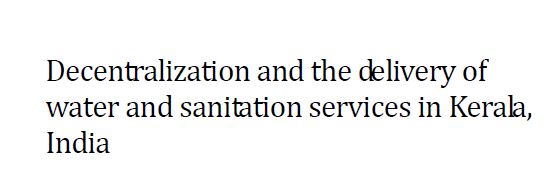Decentralization and the Delivery of Water and Sanitation Services in Kerala, India.
For the past quarter century, decentralization reforms have been an important force in shaping how India plans and implements development schemes and delivers public services. Within the context of a three-tiered federal system, states were mandated in 1992 to devolve key powers and functions across major sectors —including responsibility for water and sanitation—to panchayats (local councils) and municipalities, which form the third tier of government in India’s federal structure. During this same period, despite the substantial efforts being made to improve the access and quality of water and sanitation services (WSS), progress in improving WSS has been quite uneven in India. Despite extensive literatures on decentralization and water and sanitation in India, relatively little is known about the “vertical” aspects of water and sanitation provision in the country, or about the institutional intersection between local governance institutions and water and sanitation services. In fact, quite some confusion seems to exist about the extent to which the delivery of water and sanitation is actually decentralized below the state level. This study aims to shed light on the vertical organization of water and sanitation services in India, and seeks to analyze how decentralized water and sanitation provision interacts with decentralized governance arrangements. In doing so, we want to identify whether (or the extent to which) vertical or intergovernmental aspects of water and sanitation provision form a binding constraint on efforts to expand access to (and quality of) water and sanitation services—especially to poor and underserved populations. Because India is vast country—with considerable differences in public sector practices between different states—it was decided to consider decentralized water and sanitation services in a single state.1Among the states of India, Kerala is a state where decentralization has been pursued to a considerable extent, with the transfer of development functions and different types of funds to the lowest tier of government. As such, this case study seeks to analyze the state of decentralization in the delivery of water supply and sanitation in Kerala. We pursue this question in a way that allows us to compare the state of decentralization in the delivery of water and sanitation services in India—and Kerala in particular—to decentralized water and sanitation provision in other countries. For this purpose, this report follows an assessment methodology for decentralized water and sanitation developed jointly by the World Bank’s Water Global Practice and Governance Global Practice (World Bank, 2016). The methodology systematically considers six dimensions of decentralized water and sanitation provision: (i) the organizational structure of water and sanitation services; (ii) the assignment of functional responsibilities; (iii) effective and responsive local political leadership; (iv) local control over administration and service delivery; (v) local fiscal autonomy and local financial management; and (vi) local participation and accountability mechanisms.
